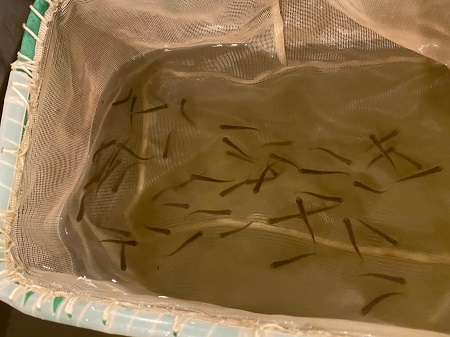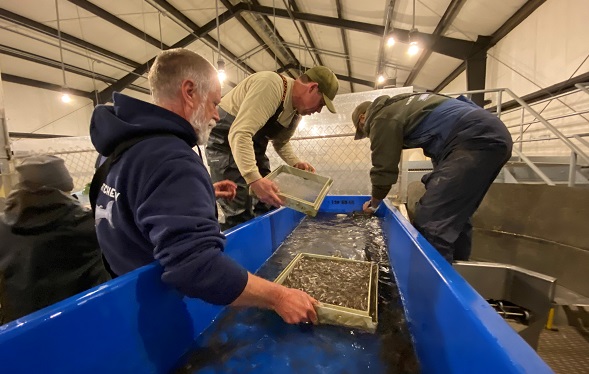CDFW Environmental Scientist Emily Fisher checks DNA tagged fall-run Chinook salmon fry prior to their release into the American River in February 2023.
Under cover of darkness and with a series of cold, late-winter storms building, California Department of Fish and Wildlife (CDFW) staff gingerly released approximately 1.1 million fall-run Chinook salmon fry (Oncorhynchus tshawytscha) into the American River at the Nimbus Fish Hatchery in Sacramento County.
It was an evening of firsts for CDFW on Feb. 23, 2023. It was the first release of fall-run Chinook salmon into the American River in more than three years. Since the spring of 2020, drought conditions have forced the trucking of Nimbus Fish Hatchery juvenile salmon to points within the San Francisco and San Pablo bays.
 It was also the first time in decades CDFW has released fall-run Chinook salmon at such a small size. The salmon fry, just three months old and only 1.5- to 2-inches in length, had just absorbed their yolk sacks and had not yet been fed by the hatchery. Typically, fall-run Chinook salmon released from the hatchery are about 6 months old and 3.5- to 4-inches in length.
It was also the first time in decades CDFW has released fall-run Chinook salmon at such a small size. The salmon fry, just three months old and only 1.5- to 2-inches in length, had just absorbed their yolk sacks and had not yet been fed by the hatchery. Typically, fall-run Chinook salmon released from the hatchery are about 6 months old and 3.5- to 4-inches in length.
“By putting these fish out into the river now, they are going to experience the natural environment of the lower American River as natural-origin fish would,” said Jay Rowan, who oversees CDFW’s Fisheries Branch.
Most importantly, the 1.1 million fry released into the Nimbus Basin represent CDFW’s first experiment with DNA tagging fall-run Chinook salmon, what’s formally known in fisheries circles as “parentage-based tagging” or “PBT.” The emerging practice is also being tested at the Coleman National Fish Hatchery near Redding and has been widely used in the Pacific Northwest – but has never been attempted before by CDFW-operated hatcheries.
Not only are the experimental salmon fry half the age and half the size of typical, hatchery-released salmon smolts, they lack the adipose fin clips to visually identify them as hatchery-origin fish and are also without coded-wire tags that can later provide scientists with information about their life history. Instead, these salmon fry are genetically linked to the parents that produced them in a far-less invasive process requiring less human handling.
Three months earlier, on Nov. 29, 2022, CDFW collected and catalogued genetic material (a tissue clip from the caudal or tail fin) from the 500 adult salmon spawned that day at the Nimbus Fish Hatchery used to produce the 1.1 million salmon fry. By collecting future tissue samples from the released fish, CDFW’s fisheries geneticists can link every individual back to the Nimbus Fish Hatchery and the exact pair of parents that produced it.
That data could start arriving as early as this spring when CDFW and coordinating organizations will begin their downstream monitoring of juvenile salmon in the lower American River, taking tissue samples from young fish collected.
“We will be able to see whether these fish are showing up in the monitoring surveys and following the same migratory cues and timing that we would expect from natural-origin fish,” said Jason Julienne, the senior environmental scientist who oversees CDFW’s Sacramento Valley anadromous fish hatcheries. “And then, over the next two to four years, we will collect genetic samples from unmarked Chinook salmon to estimate how many of these fish returned as adults to spawn.”
 About a quarter of the fall-run Chinook salmon produced at Nimbus and CDFW’s other Central Valley anadromous fish hatcheries receive coded-wire tags and adipose fin clips. With parentage-based tagging, however, every individual fish is a potential data source.
About a quarter of the fall-run Chinook salmon produced at Nimbus and CDFW’s other Central Valley anadromous fish hatcheries receive coded-wire tags and adipose fin clips. With parentage-based tagging, however, every individual fish is a potential data source.
CDFW’s research will help inform future fisheries management decisions, including the use of parentage-based tagging in coordination with current marking and tagging efforts, and could provide insight into how various release strategies contribute to survival, straying and adult returns.
“It’s going to take effort on the back end,” Julienne, said, “but we’re evaluating our long-term ability to implement PBT on a larger scale and its potential to be included as a release strategy representative of natural-born juvenile migration timing and whether it allows us to take advantage of more favorable river conditions earlier in the year.”
The 1.1 million experimental salmon fry are among 5.5 million fall-run Chinook salmon that will be raised and released by the Nimbus Fish Hatchery in 2023. That’s a recent production record, according to Nimbus Fish Hatchery Manager Gary Novak. Under normal years, the Nimbus Fish Hatchery produces 4 million fall-run Chinook salmon smolts for the U.S. Bureau of Reclamation as mitigation for the loss of spawning and rearing habitat associated with the construction of the Nimbus Dam. This year, production targets have been increased to help address issues related to drought and a thiamine deficiency impacting Sacramento Valley salmon populations. Even with near-ideal weather and river conditions accompanying the experimental salmon fry release, both Julienne and Novak acknowledged the long odds facing the fish on their journey to the Pacific Ocean.
Said Novak: “By conducting this release at night, we’re hoping to reduce predation from birds and, hopefully, give these fry a head start in finding good rearing habitat in the river.”
CDFW photos
###
Media Contact:
Peter Tira, CDFW Communications, (916) 215-3858